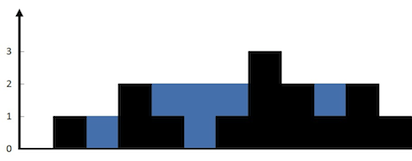Description
Given n non-negative integers representing an elevation map where the width of each bar is 1, compute how much water it can trap after raining.
Example 1:

Input: height = [0,1,0,2,1,0,1,3,2,1,2,1] Output: 6 Explanation: The above elevation map (black section) is represented by array [0,1,0,2,1,0,1,3,2,1,2,1]. In this case, 6 units of rain water (blue section) are being trapped.
Example 2:
Input: height = [4,2,0,3,2,5] Output: 9
Constraints:
n == height.length1 <= n <= 2 * 1040 <= height[i] <= 105
Code
類似 Largest Rectangle in Histogram、Maximum Score of a Good Subarray,都有用到 l_wall, r_wall 以及 monotonic stack 的概念。
Two Pointer
Time Complexity: , Space Complexity:
可看到兩種不同的 Wall 的計算方式,會導致 trap 的計算方式不同。
class Solution {
public:
int trap(vector<int>& height) {
int n = height.size();
vector<int> LWall(n, 0);
vector<int> RWall(n, 0);
int Lmax = 0, Rmax = 0;
for(int i = 0; i < n; i++) {
LWall[i] = Lmax;
Lmax = max(Lmax, height[i]);
}
for(int i = n - 1; i >= 0; i--) {
RWall[i] = Rmax;
Rmax = max(Rmax, height[i]);
}
int trap = 0;
for(int i = 0; i < n; i++) {
trap += max(min(LWall[i], RWall[i]) - height[i], 0);
}
return trap;
}
};
class Solution {
public:
int trap(vector<int>& height) {
int n = height.size();
vector<int> l_wall(n, 0), r_wall(n, 0);
l_wall[0] = height[0];
r_wall[n - 1] = height[n - 1];
for(int i = 1; i < n; i++) {
l_wall[i] = max(l_wall[i - 1], height[i]);
}
for(int i = n - 2; i >= 0; i--) {
r_wall[i] = max(r_wall[i + 1], height[i]);
}
int water = 0;
for(int i = 0; i < n; i++) {
int h = min(r_wall[i], l_wall[i]);
water += h - height[i];
}
return water;
}
};Monotonic Stack
Time Complexity: , Space Complexity:
To implement this we use a stack that store the indices with decreasing bar height, once we find a bar who’s height is larger, then let the top of the stack be bot, the cur bar is ir, and the previous bar is il.
關鍵在於:monotonic stack 適合運用在需要尋找 i < k < j and A[i] > A[k], A[k] < A[j] 或是 A[i] < A[k], A[k] > A[j] 等等山坡形或是倒三角形。只要保持 stack 為嚴格遞增或是遞減即可。
code 的寫法與解題邏輯和 Largest Rectangle in Histogram 類似。都是要尋找斷點,只是在找 largest rectangle 時是在尋找左右兩邊第一個比自己矮的,而在這題當中是要尋找比自己高的,所以 monotonic stack 在前者中是 monotonic increasing,而在這題中是 monotonic decreasing。
class Solution {
public:
int trap(vector<int>& height) {
int n = height.size();
int trap = 0;
stack<int> st;
for(int i = 0; i < n; i++) {
while(!st.empty() && height[st.top()] <= height[i]) {
int h = height[st.top()]; st.pop();
int left = st.empty() ? 0 : height[st.top()];
int right = height[i];
int idx = st.empty() ? -1 : st.top();
trap += max(min(left, right) - h, 0) * (i - idx - 1);
}
st.push(i);
}
return trap;
}
};